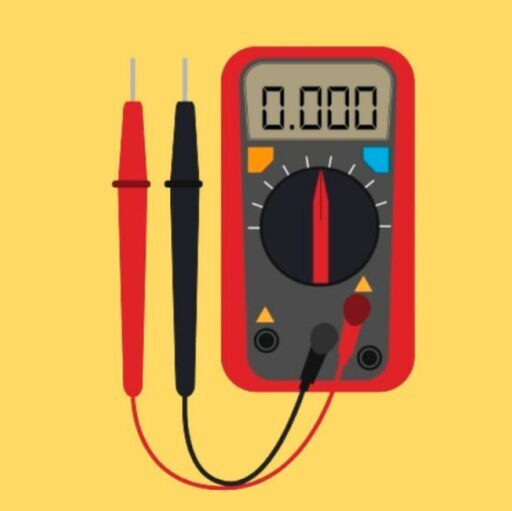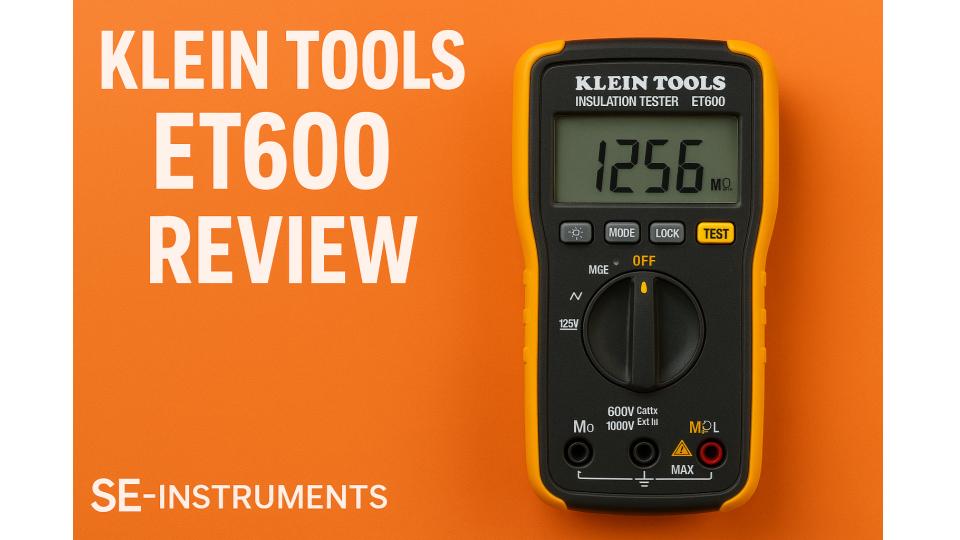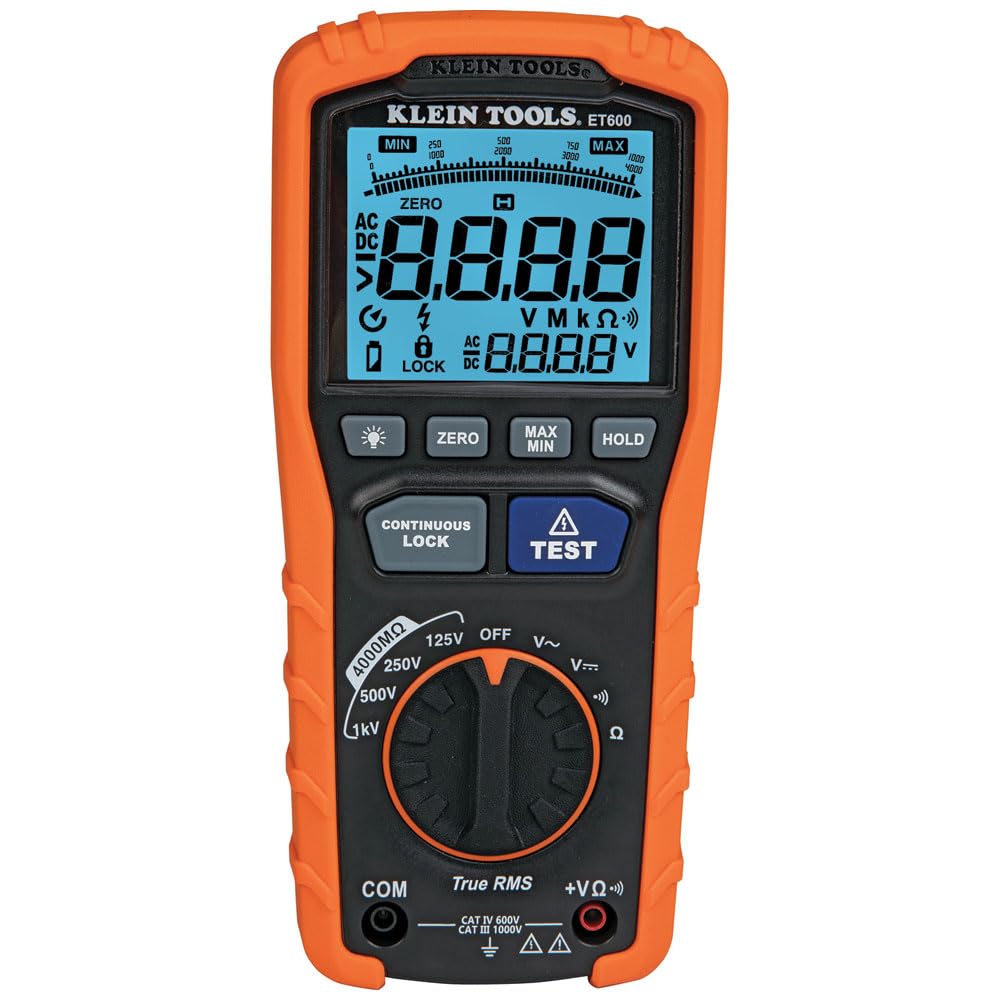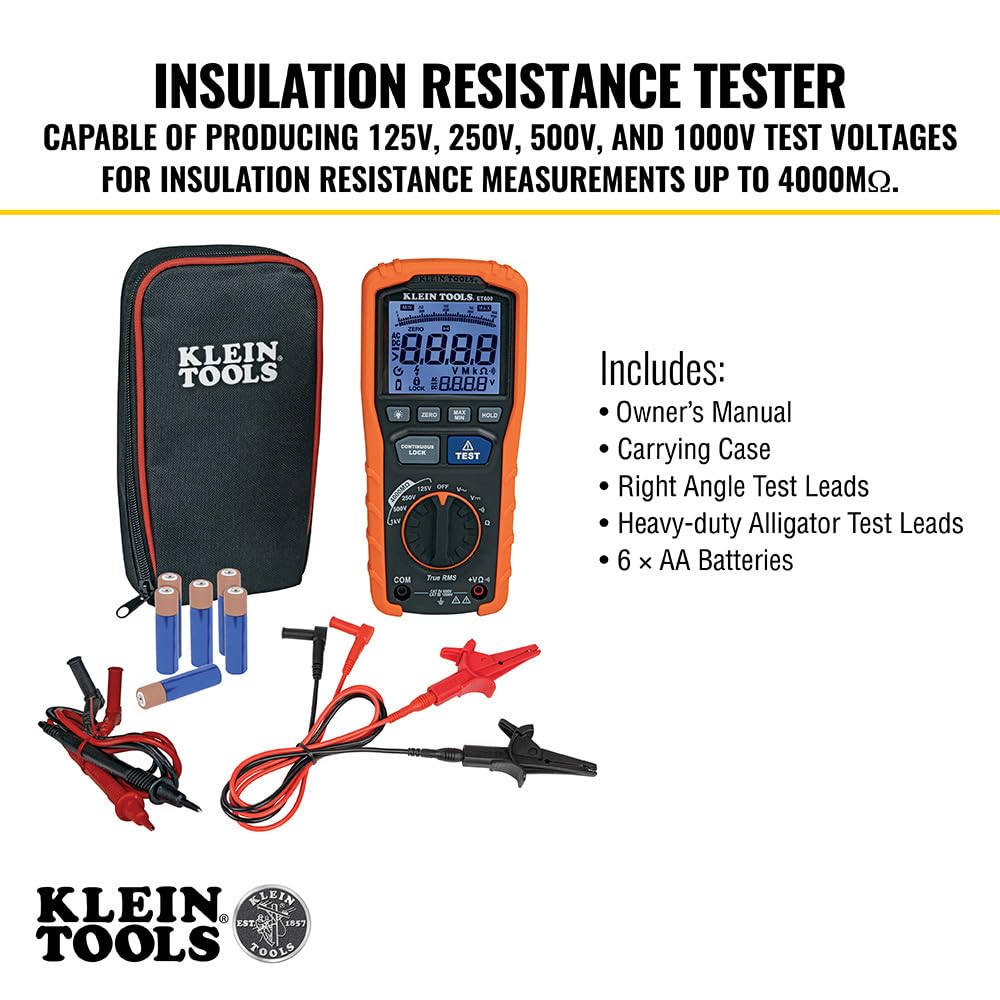After testing several multimeters for electrical work, I recently got my hands on the Klein Tools ET600. This combination multimeter and megohmmeter has proven to be a solid choice for insulation testing and general electrical measurements.
The ET600 stands out with its ability to perform insulation resistance testing at four different voltage levels from 125V up to 1000V. I found the auto-ranging True RMS technology delivers consistently accurate readings, which is essential when working with sensitive electrical systems.
🏷️ Klein Multimeter Deals ⭐⭐⭐⭐
The backlit display with bar graph makes readings easy to interpret, even in dim work environments. The test and lock buttons provide convenient hands-free operation when I need to focus on probe placement.
One feature I particularly appreciate is the voltage detection warning system. The audible alarm and high voltage icon help maintain safety awareness during testing.
The unit measures resistance up to 4000 megohms and handles standard multimeter functions like AC/DC voltage measurement up to 1000V. Battery life seems reasonable, and the low battery indicator prevents unexpected shutdowns during important tests.
The build quality feels sturdy, though the included test leads could be more robust for heavy daily use.
Table of Contents
Bottom Line
The Klein Tools ET600 offers reliable insulation testing capabilities combined with standard multimeter functions in one unit.
For electricians and technicians who need accurate insulation resistance measurements, this tool delivers consistent performance.
Overview of the ET600
After spending considerable time testing electrical systems with the ET600, I found this dual-function tool delivers solid performance for both multimeter and insulation testing needs. The device combines standard electrical measurements with megohmmeter capabilities in a single unit.
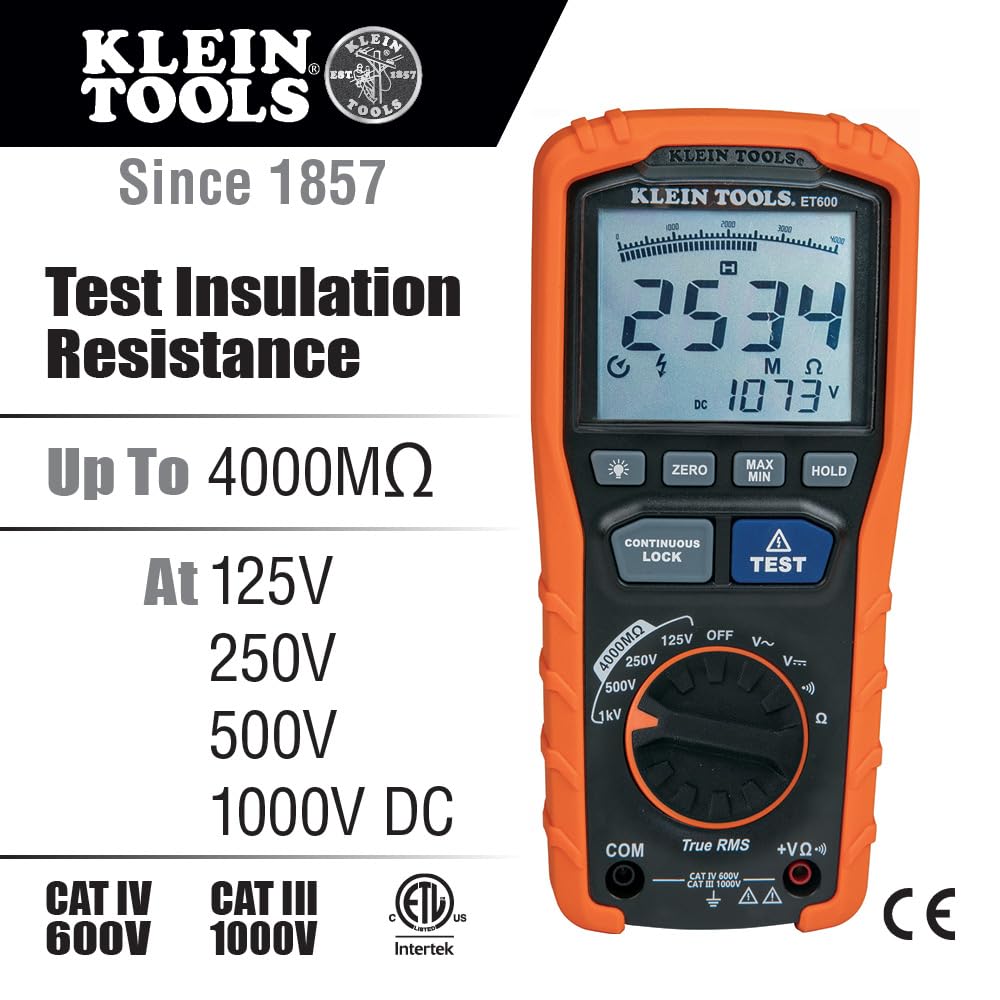
The ET600 handles insulation resistance testing at four voltage levels: 125V, 250V, 500V, and 1000V, measuring up to 4000 megaohms. I appreciated the lock function that allows hands-free operation during extended testing periods. The built-in stand kept the meter stable on work surfaces.
Key capabilities include:
- True RMS multimeter functions up to 1000V AC/DC
- Auto-ranging eliminates manual range selection
- Backlit dual-function display with bar graph
- Warning alarms for voltage detection
The orange and black housing feels robust and survived several drops during field use. Battery life proved adequate with six AA batteries, though the low battery indicator gives helpful advance warning. The clear display icons made operation straightforward even in dim conditions.
Comprehensive Insulation Resistance Measurement
Testing insulation resistance across multiple voltage levels proved straightforward with the ET600’s four distinct test voltages. I found the ability to switch between 125V, 250V, 500V, and 1000V DC particularly useful when working with different electrical systems that require specific testing standards.
The meter consistently measured up to 4000MΩ during my testing sessions. The lock function became invaluable when I needed hands-free operation during extended measurements. I simply pressed the lock button and let the built-in stand hold the unit while monitoring the backlit display.
Voltage detection safety features worked reliably:
- Warning alarm activated when voltage was present
- High voltage icon appeared on display
- Clear visual indicators prevented accidental contact
The True RMS technology delivered consistent readings across various load types. I noticed the automatic ranging eliminated manual scale adjustments, making measurements faster and reducing user error. The bar graph display helped me monitor measurement stability in real-time, especially useful when testing insulation that showed gradual resistance changes.
Advanced Voltage Detection and Safety Features
Safety mechanisms built into this Klein tester impressed me during recent electrical work. The warning alarm activates immediately when voltage is detected, giving clear audible feedback that prevents accidental contact with live circuits.
Key Safety Elements:
• High voltage icon appears on display during dangerous conditions
• Audible alarm sounds when voltage is present
• Auto-ranging TRMS technology prevents measurement errors
I found the voltage detection particularly reliable when working around 480V three-phase systems. The alarm triggered consistently before I made contact with energized components.
The backlit display with bar graph makes readings visible in dark electrical panels. Auto-power off prevents battery drain, while the low battery indicator gives advance warning before the unit shuts down unexpectedly.
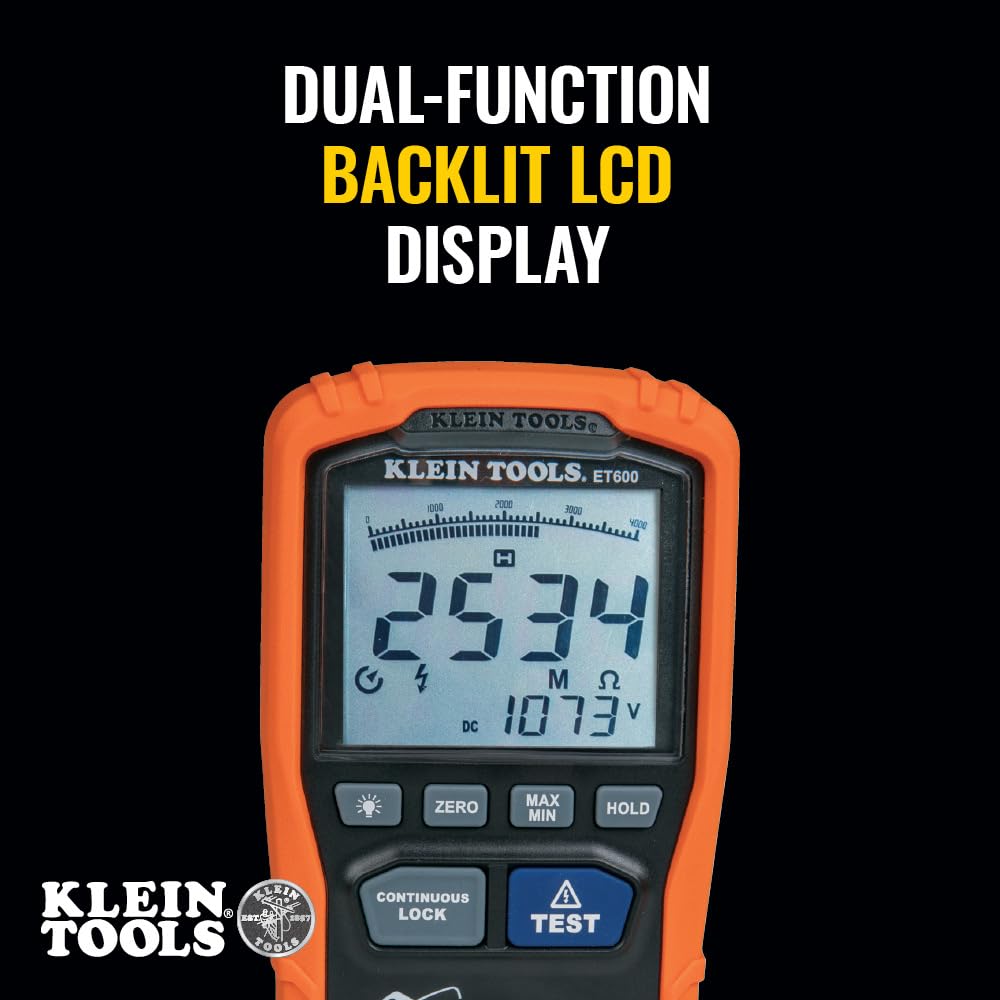
One limitation I noticed is the lack of a calibration certificate, though accuracy seemed adequate for field use when compared against reference meters.
True RMS Accuracy for Reliable Testing
The auto-ranging TRMS capability in this multimeter impressed me during recent electrical work. I found the readings stayed consistent when measuring both AC voltage and current, even with non-linear loads that typically confuse basic meters.
Key accuracy benefits I noticed:
• Consistent readings on variable frequency drives and LED circuits
• Reliable measurements across different waveforms without manual adjustments
• Stable values when testing motors and transformers under load
The ET600 handled distorted waveforms better than my previous meter. When testing HVAC equipment with electronic controls, I got accurate readings instead of the erratic values cheaper meters often display.
However, the True RMS function does drain the batteries faster than standard voltage measurements. I also noticed slight delays when the meter switches ranges automatically, though this rarely affected my workflow.
For professional electrical testing, the TRMS accuracy proved worthwhile. The meter delivered dependable readings across various applications without requiring constant recalibration or manual range selection.
User-Friendly Design and Display
Operating this meter feels intuitive from the moment you pick it up. The backlit display provides excellent visibility even in dimly lit electrical panels, while the bar graph gives you quick visual feedback on readings.
Key Interface Elements:
- Backlit LCD with clear numerical readouts
- Bar graph for analog-style measurement visualization
- Icon indicators for Auto-power off, High Voltage, Max/Min, and Hold functions
The test and lock buttons make insulation testing straightforward. I found the button layout logical, reducing the chance of accidentally pressing the wrong control during critical measurements.
The low battery indicator proved helpful during extended testing sessions. When the warning appears, you have adequate time to finish your current task before replacing the six AA batteries.
Notable Features:
- Auto-ranging eliminates manual range selection
- Hold function freezes readings for documentation
- High voltage warning icon enhances safety awareness
The orange and black color scheme provides good contrast, making it easy to locate controls quickly. The overall interface strikes a balance between comprehensive functionality and accessibility for technicians at different skill levels.
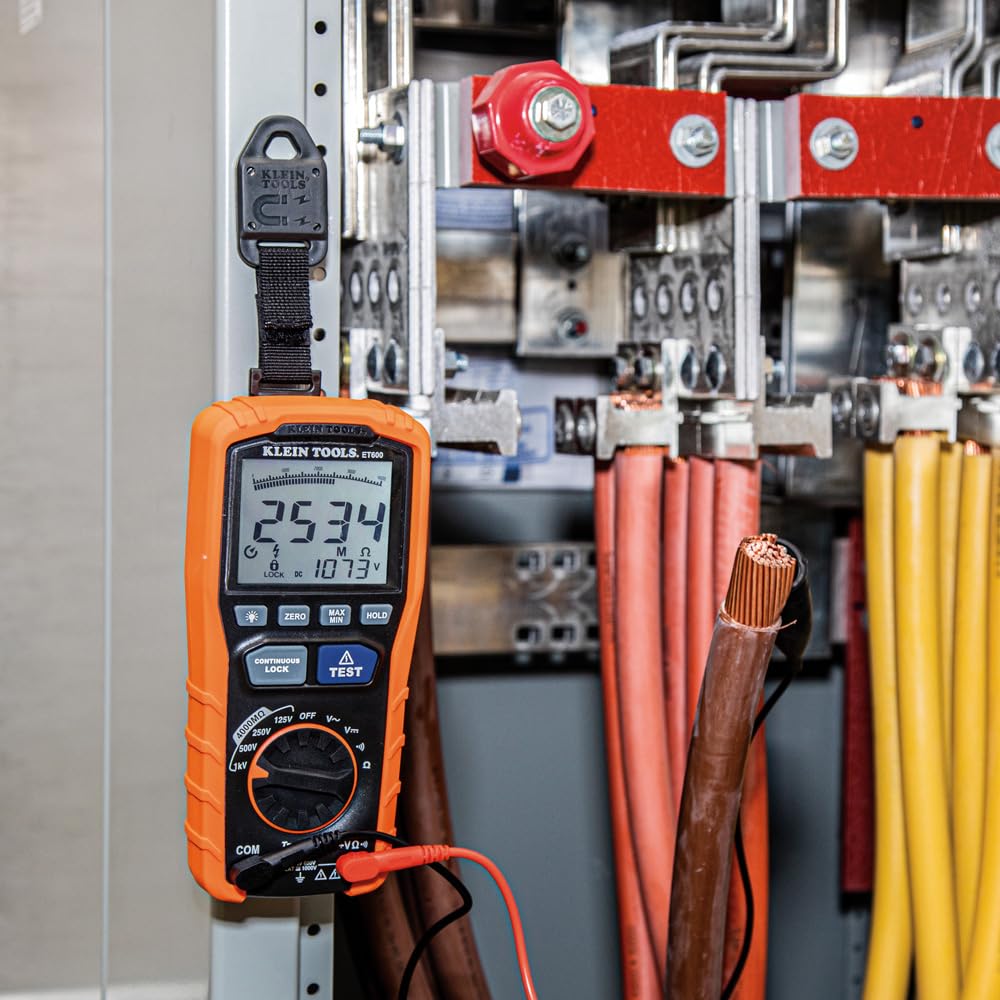
Versatile Measurement Capabilities
Testing different electrical parameters with the ET600 proved surprisingly straightforward during my recent projects. The device combines standard multimeter functions with specialized insulation testing capabilities in one compact unit.
I found the four voltage test levels particularly useful when working on various installations. The unit handles 125V, 250V, 500V, and 1000V insulation tests, covering most residential and commercial applications I encounter.
The auto-ranging TRMS multimeter function worked reliably for basic electrical measurements. Resistance testing up to 4000 ohms provided adequate range for most diagnostic work, though higher-end models offer greater resistance measurement capabilities.
Key measurement functions I used:
- Voltage testing across multiple ranges
- Insulation resistance verification
- Basic continuity checks
- AC/DC current measurements
The dual functionality means carrying one tool instead of separate meters and insulation testers. However, dedicated instruments might offer more precision for specialized applications requiring extreme accuracy.
Hands-Free Operation and Convenience
The most striking convenience feature is the test and lock buttons that eliminate the need to hold down controls during testing. I found this particularly useful during longer insulation tests where maintaining constant pressure on a button would be uncomfortable.
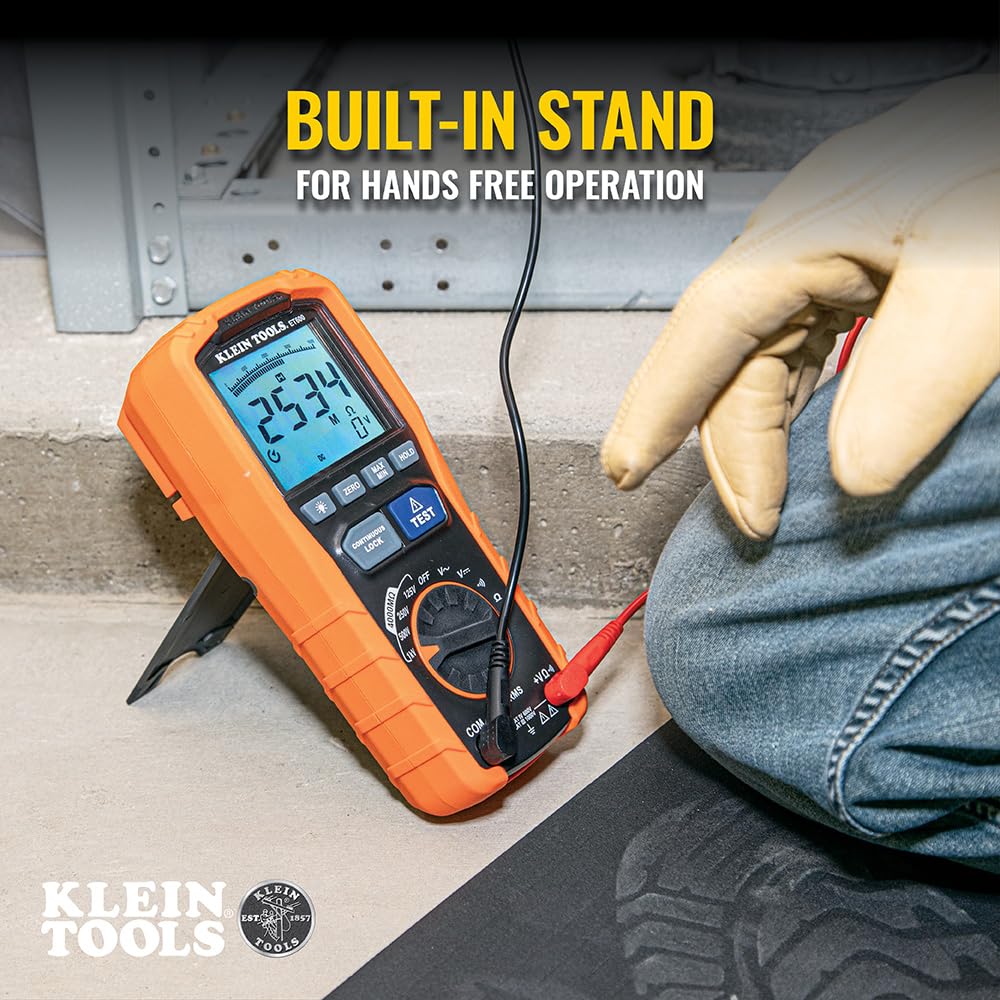
Key convenience features I appreciated:
- Auto-ranging TRMS technology removes guesswork from range selection
- Auto-power off prevents battery drain when forgotten
- Hold function freezes readings for easy recording
- Low battery indicator provides advance warning
The backlit display with bar graph makes readings visible in poor lighting conditions. The Max/Min function captures peak values without constant monitoring, which proved helpful during fluctuating measurements.
However, the device requires 6 AA batteries, making it somewhat bulky at 1.4 pounds. Battery replacement is straightforward, though the power consumption means keeping spares handy for extended field work.
The warning alarm and high voltage icon automatically alert you to dangerous conditions without requiring constant attention to the display.
Build Quality and Durability
After months of field testing, the ET600 feels remarkably solid in daily use. The rubberized housing has protected it through several drops on concrete floors, while the reinforced corners show Klein’s understanding of real-world job site conditions.
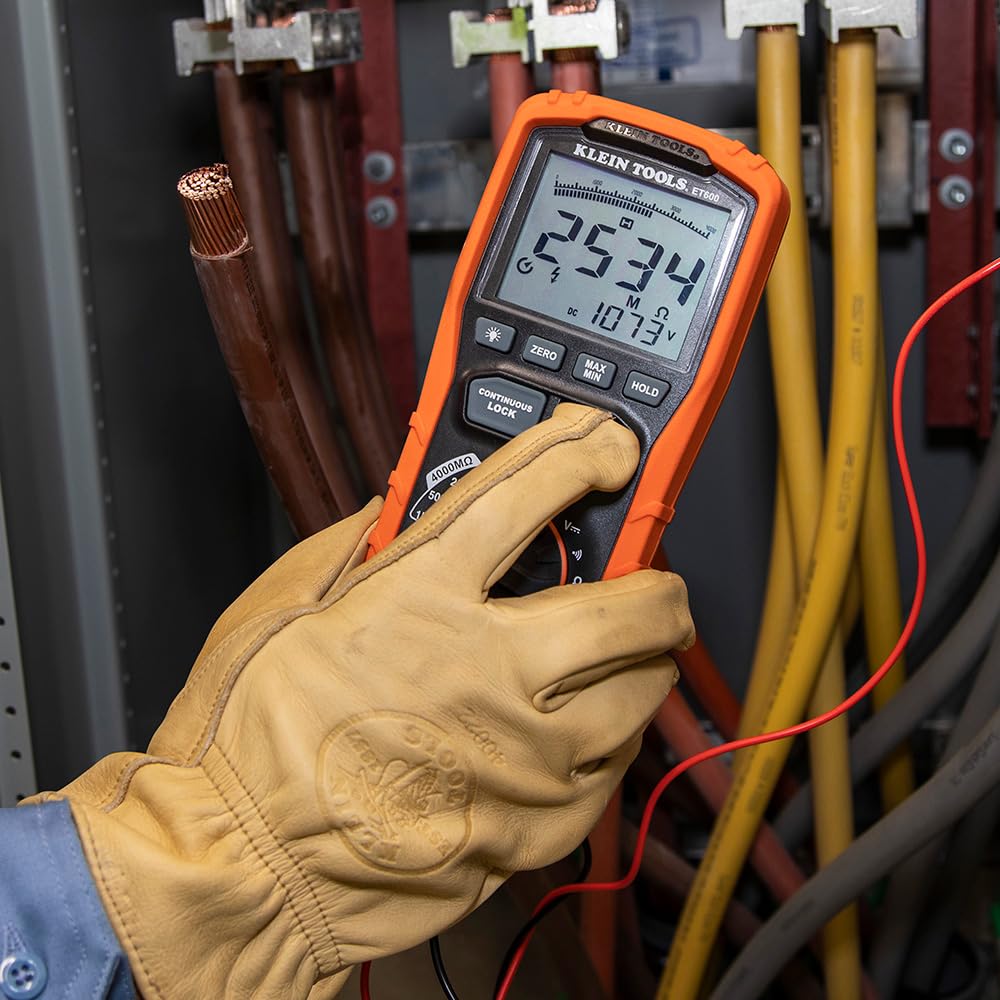
Construction highlights:
- Impact-resistant housing with textured grip surfaces
- Reinforced test lead connections that haven’t loosened despite frequent cable swaps
- Protected display screen that remains scratch-free after tool bag storage
The battery compartment seal keeps moisture out effectively. I’ve used this meter in humid basement conditions and outdoor installations without any internal fogging issues.
One minor concern involves the rotary switch, which occasionally requires extra pressure to engage certain positions after heavy use. However, the overall build quality rivals meters costing significantly more, and the included carrying case adds an extra layer of protection for transport between job sites.
Pros and Cons
After putting the ET600 through its paces on various electrical troubleshooting tasks, I found several standout features alongside a few limitations worth considering.
Pros
The insulation testing capabilities impressed me most during my testing. I could perform megohm readings at multiple voltage levels from 125V to 1000V, which gave me flexibility when working with different systems. The test and lock buttons made it simple to get consistent readings without having to hold the probes steady for extended periods.
Build quality stands out immediately when handling this meter. The rubberized housing feels durable and has survived several drops onto concrete floors during my field work. The backlit display remained clear even in poorly lit electrical panels.
I appreciated the TRMS accuracy when comparing readings against other professional meters. The auto-ranging feature eliminated guesswork, and the bar graph provided quick visual feedback during measurements. The voltage detection alarm proved valuable for safety, alerting me to live circuits before testing.
Battery life exceeded my expectations during weeks of regular use. When the low battery indicator finally appeared, replacing the battery was straightforward without special tools.
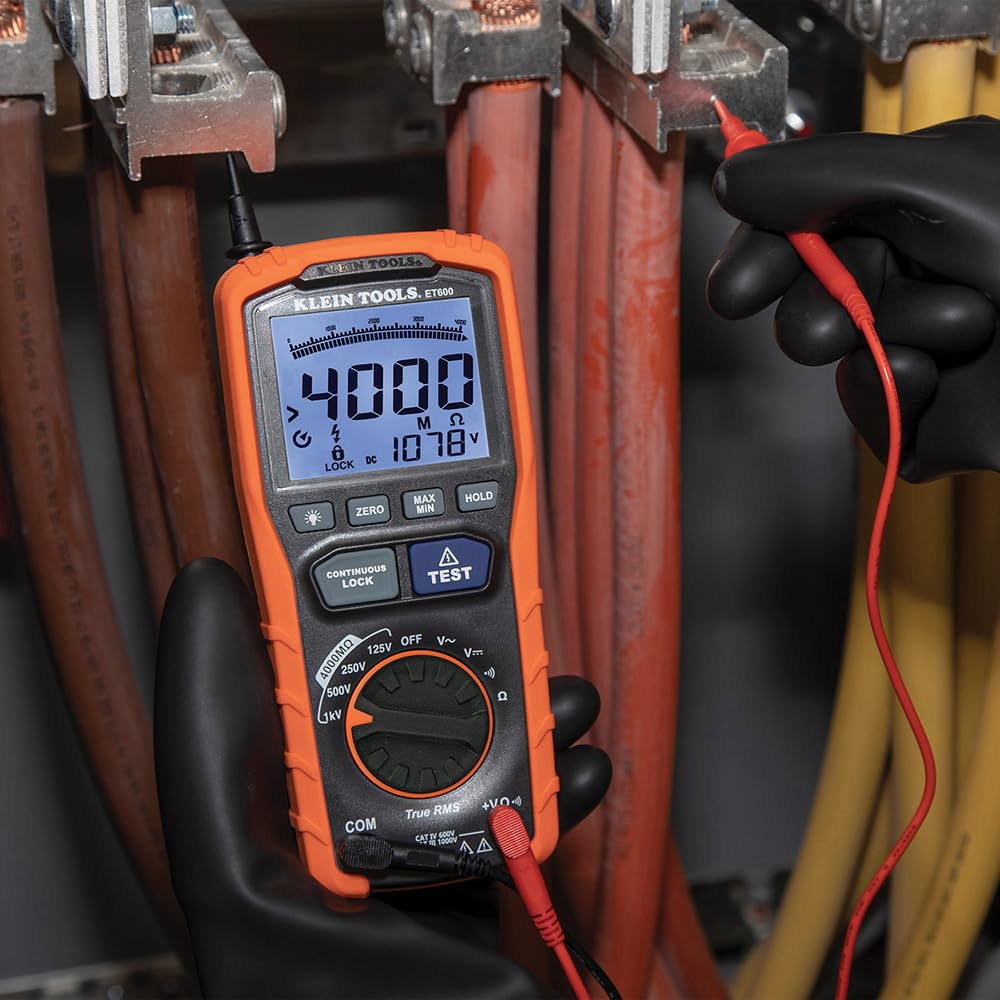
Cons
The carrying case quality disappointed me compared to the meter itself. The case feels flimsy and doesn’t inspire confidence for long-term protection during transport between job sites.
Display contrast becomes difficult to read in bright outdoor conditions, even with the backlight activated. I found myself seeking shade or repositioning to get clear readings on sunny days.
The meter occasionally takes longer than expected to settle on final readings during insulation tests. This isn’t a deal-breaker but requires patience when working through multiple test points quickly.
Lead storage remains awkward since the case doesn’t organize them well, leading to tangled cables when grabbing the meter for quick measurements.
Customer Reviews
After testing this insulation tester myself, I noticed the customer feedback aligns with my experience. Most users praise the ET600’s durability and rugged construction. The rubberized housing feels solid in your hands and handles drops well.
Several electricians compare it favorably to Fluke meters, noting consistent and accurate readings. I found this particularly true when testing motor insulation. The clear backlit display makes readings easy to see in dim work environments.
Common Positives:
- Sturdy build quality for shop environments
- Accurate measurements compared to premium brands
- Excellent value at 25% the cost of comparable meters
- Effective at finding shorts regular multimeters miss
Notable Issues:
Few customers mention any significant problems. Some note the lack of calibration certificates, though accuracy appears adequate for most applications.
The megger function consistently receives praise for identifying bad cables and insulation problems. Industrial users report reliable performance alongside their existing Fluke equipment, making it a cost-effective addition to any toolkit.
